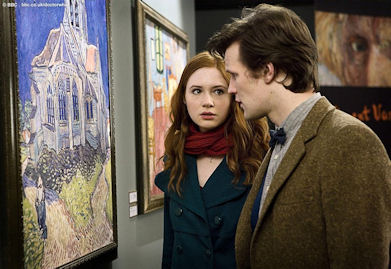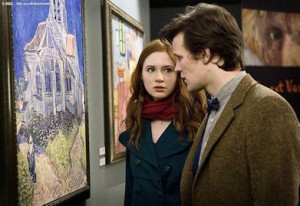[Contains Spoilers]
In the 10th episode of series 5,”Vincent and the Doctor”, the Doctor has been taking Amy where ever she wants to go, to basically make up for the last episode (even though she doesn’t remember). One of those things is to see an exhibit of the work of Vincent Van Gogh at the Musée d’Orsay in Paris. While looking at the paintings, the Doctor notices in one of them, a painting of a church, there is a scary face looking out the window at them. The Doctor then interrupts a curator, Dr. Black, who is talking about the paintings, and asks, after complimenting him on his bow tie, when the church painting was painted. He then whisks Amy off to find Vincent Van Gogh and find out what’s going on.
On the whole, this was a much better episode than the last 4 or so, in both the writing and the acting. This episode featured another famous person, but unlike other “famous people” episodes, it really focus’ on his life and work, and not on the monster that inevitably shows up. While Van Gogh is a well-known and acclaimed painter now, he wasn’t during his lifetime. This episode really shows how unappreciated he was as a painter and as a person. He couldn’t trade a painting for a bottle of wine, and his whole body of work wasn’t worth more than the cost of a some furniture at his death. Even Van Gogh himself didn’t see the worth of his work, as he causally puts a cup of coffee on one and paints over another when the Doctor asks for a drawing of the invisible Krafayis. It was funny to see the Doctor’s and Amy’s reactions to Van Gogh’s carelessness with his work. In the village, he is not only laughed at, he is also cursed at, and blamed for the strange deaths that are happening there. It also explores the motivations of Van Gogh himself. How he saw the world differently, sees beyond the normal eye, and that he can hear color speak to him. This part of the story was very engaging in both writing and acting.
 The other half of the story, with the Krafayis, the entire reason for the Doctor and Amy to be there, feels like it was forcibly wrenched into the story. It’s more like an afterthought. There aren’t a lot of scenes with the monster, mainly at the beginning when it is first introduced, and at the end with the fight at the church. The race is described by the Doctor as a brutal one, and that this one left behind will kill without mercy until killed. But when they finally face off against it, the Doctor realizes the creature is blind, and suddenly it doesn’t seem so villainous. That revelation really took the wind out of the sails of the fight. It became more of a mercy killing that a battle to save the village. But then, the monster really wasn’t the point of the episode.
The other half of the story, with the Krafayis, the entire reason for the Doctor and Amy to be there, feels like it was forcibly wrenched into the story. It’s more like an afterthought. There aren’t a lot of scenes with the monster, mainly at the beginning when it is first introduced, and at the end with the fight at the church. The race is described by the Doctor as a brutal one, and that this one left behind will kill without mercy until killed. But when they finally face off against it, the Doctor realizes the creature is blind, and suddenly it doesn’t seem so villainous. That revelation really took the wind out of the sails of the fight. It became more of a mercy killing that a battle to save the village. But then, the monster really wasn’t the point of the episode.
At the end of the BBC broadcast of this episode, a message came up for the BBC action line for anyone who wanted more information on the issues brought up the program. That made my husband and I go “Huh?” The Confidential better explained it. This episode had a lot of references to Van Gogh’s depression and suicide. One of the scenes in the episode showed one of his depressed episodes, and his suicide is mentioned twice. What I was really impressed about this episode, is that the theme of depression wasn’t pounded into the audience’s head. This didn’t have “very special episode” feel to it. It was just excellently written, and acted. The actor who portrayed Vincent, Tony Curran, not only did a fantastic job portraying Van Gogh, he really did look like him! That’s his real beard and mustache that he grew for the part. The writer, Richard Curtis, did a lot of research into Van Gogh, and went to Steven Moffat with the episode idea. This might explain why the monster part didn’t fit as well.
But the best scene of the episode, and one of the most memorable of the season, is at the end. The Doctor decides to give Van Gogh a gift before leaving, and takes him to the future, to the Musee d’Orlay, to the exhibit that the Doctor were at the beginning of the episode. He then asks Dr. Black what he thinks of Van Gogh’s work. Dr. Black then goes into a whole explanation of how the thinks Van Gogh was not just one of the greatest painters, but one of the greatest men of all time, all without knowing that Van Gogh himself is standing right behind him, listening. Van Gogh is truly grateful to the Doctor for his kindness, and Amy thinks their act will have changed Van Gogh, and that there will be more works by him at the museum. But a return to the present shows nothing has changed. Minor things have, such as the face in the church is gone, and now the painting of Sunflowers is dedicated to Amy, but knowing what the future will think of his work couldn’t keep Van Gogh from killing himself.
This was an excellent character driven story, which was a good reprieve after all the plot driven/crack in time/doom and gloom stories we’ve had recently. Even though it isn’t a completely happy ending, it’s not a surprise either. It’s a bit of a tear-jerker, but not in a cheap way.
Images © BBC




